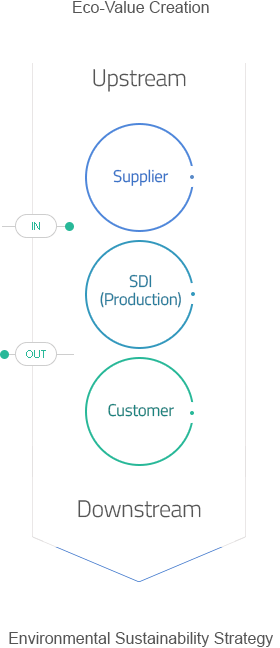To Create Eco-value
In 2003 when Samsung SDI began sustainability management, it established the goal of environmental sustainability as eco-value creation.
It indicates that externally a company contributes to the society by creating eco-values and internal environment as one of three aspects of business management creates critical values.
To this end, Samsung SDI set out five strategies across all processes of corporate activities. The five strategies are composed of an integrated environmental management system for continuous improvement of organizations and system, environmental supply chain management to build the green partnership with suppliers, cleaner production for least resource use and minimization of pollution, eco-design to create environmental values for customers, and interactive communication. Accordingly, Samsung SDI has established and action plans for each strategy and been continuing their execution.


Supply Chain /Environmental Management
SDI (Production)Cleaner Production Technology
CustomerEco-Design
INIntegrated Environmental
Management System
Interactive Communication
To create true eco-values, the company needs to inclusively control every process related to the management and make green partnerships with the environment, partners, customers, and the society. For the environment, in particular, the company has to take less from it and emit less as well. On the other hand, the company has to more cooperate and exchange with its partners, customers, and the society. This is the direction that Samsung SDI is heading in pursuit of environmental sustainability.


Samsung SDI has sought to achieve the goals of eco-value by developing greener products, strengthening eco-friendly cooperation with suppliers, and developing manufacture processes that can cause minimal impact to the environment.
| KPI | Unit | Base year (2015) | 2017 | Goal (2020) |
|---|---|---|---|---|
| KPI GHG (Greenhouse Gas) Emissions | unit tCO2e |
Base line (2015)
1,099,587 (2020 BAU) |
2017 919,382 |
Goal (2020)
Reduced by more than 30% compared to BAU* (1,099,587tCO2e) |
| KPI Water Consumption | unit 1000 tons / 100 million won | Base line (2015) 0.11 | 2017 0.10 | Goal (2020) Improved more than 2 times |
| KPI Hazardous Chemical Use | unit ton / 100 million won | Base line (2015) 0.43 | 2017 0.41 | Goal (2020) Improved more than 2 times |
| KPI Waste Emissions | unit ton / 100 million won | Base line (2015) 0.97 | 2017 1.15 | Goal (2020) Improved more than 2 times |
| KPI Recycling Rate of Waste Products | unit % | Base line (2015) 96 | 2017 95 | Goal (2020) Maintained above 95% |
| KPI Reclamation Rate of Waste Products | unit % | Base line (2015) 4 | 2017 5 | Goal (2020) Maintained below 5% |
- * GHG BAU reduction goal only applies to the energy business area.











